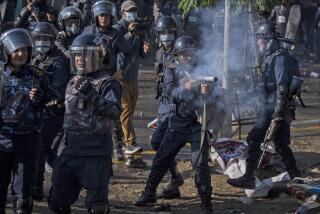Prince’s Uncle Recounts Killings
- Share via
KATMANDU, Nepal — The royal slaughter here started with the killing of the king--shot by his angry, drunken son, Crown Prince Dipendra, the prince’s uncle said Wednesday.
After shooting his father, Dipendra sprayed a roomful of guests with fire from his assault rifle, his uncle said. In the end, the bloodied ornate halls and garden of the palace were strewn with the bodies of the prince’s parents, his brother and sister and five others. Then Dipendra killed himself.
There was still no official explanation of Friday night’s massacre. But with many Nepalese angry and convinced that the truth won’t be told, several royals stepped forward Wednesday and gave accounts.
Suraj Shamsher Rana, brother of slain Queen Aishwarya, said the crown prince went on his killing spree after his father, Birendra, threw him out of a gathering of about two dozen members of the royal family and wealthy friends at Narayanhiti Palace.
Rana, who was not present at the gathering, said he spoke to several witnesses and survivors. Another of his sisters--the new queen, Komal Shah--was hurt, and he has visited her several times in the hospital.
His account was confirmed in an interview on independent Star TV by Neer Shah, whose brother was married to Princess Sruti, Dipendra’s sister. Shah’s brother was wounded.
Meanwhile, the editor of Nepal’s largest daily newspaper and the two top managers of its publishing company were arrested and jailed Wednesday on charges of sedition, apparently over publication of a politically sensitive opinion piece.
Authorities did not explain the arrests, the first such actions against the press since Nepal became a parliamentary democracy 11 years ago.
But other editors at the newspaper, Kantipur, said they believe it was because Wednesday’s edition contained an op-ed column by a senior underground leader of Nepal’s revolutionary Maoist party, which has been waging a violent insurgency for five years.
The op-ed piece, written by Maoist ideologue Baburam Bhattarai, condemned the slayings as a “grave political conspiracy” backed by feudal and foreign forces. Virtually calling for an army coup, it compared the killings to the 1846 Kot Massacre, a pivotal event in Nepali history when the current Shah monarchy was driven from power for more than 100 years by the Rana dynasty.
More to Read
Sign up for Essential California
The most important California stories and recommendations in your inbox every morning.
You may occasionally receive promotional content from the Los Angeles Times.













